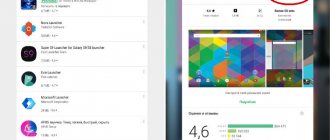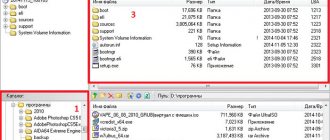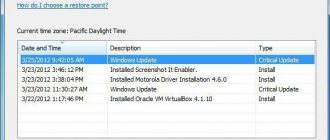DVD Slideshow GUI
This is a free program, very easy to use, that allows you to create videos with slideshows from photos
and videos in various formats. The perfect way to turn your digital photo albums into videos and show them to friends and family. Includes many animations, transition effects and allows you to add captions and background music to your slideshow, customizing every little detail. It is not in Russian, but it is extremely easy to use even for less experienced users, the results obtained can be mastered directly by clicking on the program icon.
Edit any pages
Realize your ideas - the photo book program can be downloaded for free from our website. “Photo COLLAGE” has a lot of built-in tools for creating high-quality projects, so you can think through the content of each page in detail.
Viewing a photo book will become much more interesting if you add captions to the pictures. This is especially true for pages that use a large number of images. You can add inscriptions in the “Text and Decorations” menu: just enter the necessary information and customize the appearance of the layers.
If you are creating a photo book with children's photographs or simply think that the project looks boring, visit the clipart catalog. Here you will find hundreds of images on various topics. Find the ones that suit your project and then drag them onto the sheets. If desired, make more global edits to the layout: select new frames for photos, change the background of individual or all pages at once, and much, much more!
If desired, change any elements in the template
Create a book from any photographs with your own hands! for the photo book “PhotoCOLLAGE” right now and create an effective photo story based on past events in a matter of minutes.
Digital photo album Epson P-5000
What happens if you combine a capacious hard drive, a large and high-quality LCD display and a battery in one case, adding to this a number of external interfaces (at a minimum, a standard USB for exchanging data with a computer, and at a maximum, also support for memory cards or USB- host)? Typically, such devices are positioned by all manufacturers as media players. Epson considers this direction to be photo albums. The logic is clear - for the company the most significant direction is photography, and not video or music. And in terms of support for working with photographs, the albums of the P-x000 series are somewhat superior to mass-market players: what about just the support for the RAW format or the now so rare possibility of direct printing on USB printers? We are not talking about the possibility of using the device as a photo storage device - some time ago many manufacturers experimented with memory card slots, but today this is not common.
But don’t think that the matter is limited only to photographs. There are no problems with music or even video, which allows these “photo albums” to easily compete with video players. Moreover, recently their interest in this capacity has grown significantly - manufacturers are increasingly switching to flash memory. Yes, this allows you to reduce the size of the device, reduces susceptibility to shaking, etc., but only at the cost of reducing the available memory. And although the difference in this parameter between devices on flash and hard drives is constantly shrinking (as the former becomes cheaper), it still amounts to several times. So there is still interest in hard drive players. Moreover, to the maximum functionality - if a person is ready to carry a rather heavy device with him, then a completely logical requirement for the latter is maximum capabilities without purchasing additional modules. But the supply on the market is quite meager. Let's see - how can Epson help us in this regard?
The current line includes four models, differing in the diagonal of the built-in display and the capacity of the installed hard drive. We tested the older one - P-5000.
| Manufacturer | Epson |
| Name | P-5000 |
| Dimensions | 150 × 88.7 × 33.1 mm |
| Weight | 438 grams |
| Memory | 80 GB 2.5″ HDD |
| Display | 4″ color LCD, 640 × 480 pixels, 16.7M colors |
| output power | 20+20 mW |
| Interface | USB 2.0 |
| Audio formats | MP3, WMA and AAC (.m4a) |
| Video formats | MPG, AVI, WMV, etc. (full list below) |
| Graphic formats | JPEG, RAW |
| FM radio | No |
| Audio recording | No |
| Battery | Replaceable Li-Pol |
| Peculiarities | USB host, slots for CF and SD/SDHC, support for printing to a printer, video output |
General impressions
Having worked with flash memory players for a long time, we, frankly speaking, have become unaccustomed to such sizes and weight. However, as we will see later, they “pay off” with the positive features of the device - in fact, a four-inch display, a “laptop” hard drive, a replaceable battery, two slots for flash cards and other “assorted” interfaces do not allow one to hope for a compact design. So here everyone has a choice - either make compromises, or get used to the rather large size and weight of almost half a kilo. Alas, it is still not possible to be rich and healthy at once.
If we ignore the dimensions, the R-5000 is extremely similar to most similar devices. Most of the front surface is occupied by the display. Moreover, the matter is not limited to a 4″ diagonal and support for full VGA resolution - according to information from the company, the display uses four light filters, versus the usual three, which allows for a wider color gamut. In this model, it (again, according to the company) almost matches Adobe RGB. We did not carry out direct measurements of the color gamut, but visually the display makes an extremely pleasant impression. Even when viewing photos taken in “normal” sRGB mode. However, it is clear that there will always be a “quality increase” due to display parameters - even for video, and not just for photos, which will be helped by the large diagonal and relatively high resolution of the display. However, from the latter, it obviously follows that no one optimized the device specifically for video - otherwise a widescreen display with an aspect ratio close to 16:9 would have been used, and not VGA. However, the company does not position the device as a video player.
The main controls are forlornly nestled to the right of the display (only the button lock slider, combined with the power switch, did not fit there - it ended up on the right side as a result). There are quite a few of the latter - if you count the four-way navigation key as one, you still get eight. This number allows you to perform most operations without having to operate the menu, which is quite convenient. An interesting detail is the presence of image scaling buttons, which also control the volume. Actually, everything is similar to players, but in the latter these buttons are called just volume control, and the scale is changed “concurrently”.
Most communication connectors are hidden on the left side of the device under rubberized covers. There was no room for memory slots, so they were placed on top. There is also a headphone jack, and at the bottom there is a speaker, which allows, for example, two or three people to watch a movie.
With the exception of some minor details, the similarity with media players is almost complete. But the devil, as we know, is in the details.
Switching
The difference in design approaches is clearly visible in how the device communicates with the outside world. Most player manufacturers are now limited to only banal support for USB 2.0 for connecting to a computer and wireless interfaces - Wi-Fi for direct support for connecting to the Internet and Bluetooth for working with wireless headphones. A USB host is found only occasionally, in a low-speed modification; support for memory cards is available a little more often, but mainly as a means of expanding the built-in memory. Epson takes a slightly different approach.
Of course, USB 2.0 is used as a standard interface for working with a computer. This bus is used only for data transfer - the device is powered exclusively from the mains or built-in battery, and the latter is recharged exclusively from the power supply, but not from USB. This is a minus. An advantage is the excellent speed characteristics when exchanging data with the built-in hard drive - when copying movies to the device, we got a speed of around 30 MB/s, that is, the USB capabilities in this case are utilized almost completely. In addition, the device can be used as a card reader with support for SD/SDHC and CompactFlash cards. However, you shouldn’t count on high speeds - for both some and others we got about 2.9 MB/s both when reading and writing data. This is several times less than on the best individual card readers, but still somewhat faster than on most cameras when they are directly connected to a computer, so these capabilities will probably be used, although not always.
But the most interesting feature associated with the presence of two slots for memory cards is the function of directly copying information from them to the built-in hard drive, which makes the photo album a competitor to various “photo hard drives.” Copying a set of 157 JPEG files with a total weight of 424.1 MB took 90 seconds in the case of CF, and 75 seconds with SDHC. The device cannot perform any checks, so you can only hope that there will be no errors during copying. For comparison, HyperDrive Space performs a similar operation in 43/97 seconds in the default mode, that is, with a bit check of every seventh sector; without checks, this operation is performed about a quarter faster. However, Space is one of the fastest devices of its kind, and even then, as we see, in the case of SDHC cards, the copying speed in the case of both devices is quite comparable. Many inexpensive drives are much slower, and not all of them still support SDHC. So the overall verdict is positive: if you need the fastest and easiest copying of files from cards, then it is better to purchase a specialized drive, but for a multifunctional device, the P-5000’s capabilities in this regard are very good.
The device also has a USB host. True, a noticeable disadvantage of the latter is that when operating from a battery, power is not transferred to the latter, so you will have to forget about the ability “in the field” to quickly dump the contents of a flash drive or any memory card onto the hard drive using a separate card reader - devices will only work with own food. When using the power supply everything works. The speed was only slightly lower than when using the card slot - the procedure for copying the same set of files from an SDHC card using a multi-format card reader took 95 seconds. But the main application of the host is not copying data, but directly supporting direct printing to a printer that supports USB Direct Print, without using a computer. You can print not only photographs, but also images from video files. Of course, using a computer in this case is more convenient, but the main thing is that such a possibility exists in principle.
By the way, speaking above about memory slots and USB host, we mainly focused on copying data to the device. In fact, the reverse operation is also supported - copying data from the device to the outside world. And even a slightly more cunning combination - copying data from a memory card to an external USB device. In some cases this can be extremely useful. Owners of video cameras on memory cards will be especially pleased. In this case, even the 80 GB hard drive built into the album may not be enough for a long trip, but you can also take a simple USB HDD with you to expand the available disk space. And for video files, the ability to “reset” footage from cards is even more important than in the case of photographs - while memory cards, despite all the price reductions, are quite expensive, and the volume required is large: video is not a photo.
Last on the list, but not least, the communication feature is a regular composite video output, which allows you to view photos or movies on a large screen (if you have one nearby). Additional accessories, with the exception of the included cable, are not required in this case, which can be considered a great advantage in our time - most video player manufacturers now strive to make extra money on accessories by selling them separately.
Audio player
Playing audio files left me with mixed feelings. On the one hand, the player is quite good, in addition to MP3 it also supports AAC with WMA, you can create playlists, music is organized into a collection, and there is a lot of space for storing it, on the other hand, a lot of things could have been done better. Although it is clear that the company did not pay too much attention to this function, since if a person only needs audio, he will most likely buy himself something small on flash, so the support was done on a “to have it” principle (not to do it - it would be funny), but... The flaws found are simple and primitive, and could be corrected by programmers very quickly. For example, the same collection. It has long been known that players that focus on this method of storing audio recordings require normally written tags in the files. However, even in the absence of the latter, nothing terrible usually happens - just all the files without tags fall into one heap, but they can at least be found by name. Can. In the case of Apple, Archos, Creative, etc. it is possible, but in the case of Epson it is not possible, because when updating the library, files without tags are for some reason also renamed according to some complex law. So, of course, you will be able to find them later, but if only by chance, there will be no familiar names left either. The file browser (which exists, and is very powerful - it even supports full-fledged work with directories, up to their creation, renaming, etc.) simply does not see audio files: the entire collection “lives” in hidden folders. Could it be possible to do without renaming? Yes, you can - others somehow manage.
Or displaying information from the same tags. On the screen you can always see the title of the song, artist name, album and genre. Not bad. By additionally pressing the Display button, you can also see the codec type, bitrate and sampling rate. But you can’t see the image from the tag. Absurd! With such a display, refuse to display pictures. And do not forget that the only correctly working encoding of the Russian language in ID3 tags is Unicode. This problem is not limited to Epson, but, as the experience of many manufacturers shows, it is quite possible to fix it. For some reason this is not done here.
There is support for playing audio files, there are some service capabilities, but the P-5000 is not a full-fledged competitor to media players in this capacity. Although sometimes you can listen to your favorite album. But only in relatively comfortable conditions - either the power of the built-in amplifier is not enough, or something else (especially since in films the sound is clearly louder), but the volume is “on the edge”. It was not possible to even test the quality of the audio path using RMAA - it was not enough for this.
Video player
The device was also not specially sharpened for video, but using it in this capacity is a pleasure. There are, of course, some ergonomic flaws - in particular, all video files should be placed in the Video folder without any subfolders. Otherwise, the player itself will not find them - only if you use a file manager to access them.
But the list of supported formats is simply amazing - from the usual MPEG1 to H.264/AVC and even VOB files themselves. True, HD formats are not supported - the maximum resolution is up to 720 × 480, and in the case of H.264, 320 × 240. Why is it needed? Obviously not for HD rips, but to support video shot with all sorts of inexpensive household cameras (for the latter, the available MJPEG support will also be very useful). Together with the ability to quickly copy information from memory cards, support for some “exotic” formats from the point of view of store-bought discs (both codecs and containers) is quite capable of making the P-5000 an extremely useful purchase for the owner of a video camera designed for MPEG4. Or someone who dabbles in shooting video with cameras.
And a simpler application is to watch a movie or two on the road. Or start watching it on the road and finish it in your hotel room, connected to the TV. However, even in autonomous conditions this is quite convenient, since the display allows it. Of course, there are now players with an even more video-focused widescreen display with a resolution of 800 × 480 pixels and a diagonal of 4.3 or even 7″, but they are few. The majority of players can still offer the user only 3.5″ or less with a resolution of up to 480 × 320 pixels (and most often even less). In this case, both parameters are overlapped.
The set of service parameters also leaves much to be desired. In particular, the device correctly supports files with multiple audio tracks, allowing you to select the one you want when viewing. Similarly, it is possible to work with subtitles, that is, in fact, if we add menu support to this, we get a complete analogue of a decent player. But portable and with its own display. I was especially pleased with such, at first glance, a trifle as remembering the playback position in video files - not all players can boast of this (even stationary players have a similar problem). And you can also “handle” wide-format films, although the display is not designed for them - if you select full-screen viewing in the settings, the video file will be scaled along the long side of the display. Of course, the familiar stripes at the top and bottom will remain, but nothing will be cut off. But you can also try to watch video files with the original picture size - in this case, scaling will not be performed.
A full range of necessary service capabilities, direct support for a wide range of file formats (straight out of the box), an excellent display and a capacious hard drive make the device an excellent video player. Unlike audio support, in this case the designers from Epson have absolutely nothing to be ashamed of.
View photos
The company considers this function to be the most important - let's check if this is true. The first pleasant surprise is support not only for JPEG, but also for RAW formats of many cameras. True, the device shows the contents of the thumbnail (which is honestly stated in the manual), but such support is better than nothing. The files are not entirely equal - for example, JPEG can be scaled by 400%, and the maximum for RAW is “point to point”, although in practice this is unlikely to be a serious limitation. In contrast to the impossibility of organizing a slide show from RAW files.
The second feature that makes the device similar to specialized photo storage devices (of course, with those that generally have an image viewing function) is the ability to display the contents of EXIF tags and even histograms. This (together with RAW support) will be of most interest to “advanced” amateur photographers. And beginners will certainly appreciate the photo enhancement mode, in which the device is able to automatically recognize faces and certain scenes, and adjust the image colors accordingly. It would also be useful to organize viewing in the form of a slide show. The parameters of the latter, such as the visual effect when changing photos, the time each of them is displayed on the display, or the background audio composition, can be customized. The only pity is that the background is a bit poor - you can choose either one of three predefined melodies, or one of the music files from the custom playlist. Why there is only one, we don’t quite understand - most players now can simply display photos in parallel with listening to music (at least all), that is, for them these are independent operations, but Epson has only implemented a simpler option.
Ratings are a convenient way to organize photos. You can assign a rating to any graphic (but not audio or video file) in the range from 1 to 5, and then sort the images by it. Thus, if you need to show someone especially selected photos, this can be done easily and simply.
Software
In principle, the album does not need any additional software - as we said above, it supports the standard UMS protocol, a fairly wide range of formats, and can update the music database independently (while scanning the entire hard drive). However, for the convenience of users, the company also offers a special program in two versions - for Windows and for MacOS.
Its main functions are: transferring information to an album and back, creating backup copies of information stored on it on a computer (an extremely useful function if you use the P-5000 as the main photo storage device in the house, for example), converting formats if necessary.
Also, using the program, you can work with playlists for audio files, which is more convenient than compiling them directly on the device itself.
The nuances of the utility’s behavior (in particular, where to store backups and what format to recode video and music into when transferring to the device using Epson Link2) are configured on a special page. There are quite a lot of settings, at first glance, but that’s all they are - no more. In principle, most users will not need to touch them. Many people don’t even need the program itself - we work with the album simply, like with an external hard drive, and that’s all.
Contents of delivery
In addition to the device itself, it includes everything necessary to work with it. In particular, a cable for connecting to a computer and outputting images to a TV, headphones, a power supply and a convenient case. Also included is one battery - to the company’s credit, it did not make the power source non-removable. Moreover, the latter is very reminiscent of the developments of some other companies, fortunately it is based on the standard 18650 cell (2.3 mAh, 3.7 V) for laptops and not only. An additional one can be bought from the company itself, but it costs about $70 (even more expensive in our country), while some smart American online stores already offer “compatible” ones for only $15. From this we can definitely conclude that not only Epson has such a power source: yes, it is suitable for all albums in the P-x000 line, but if only for them, it is unlikely that the market was capacious enough to produce such products.
However, buying an original battery or looking for a compatible one is a matter of taste; for obvious reasons, the company does not recommend the second option. In any case, the opportunity to somehow purchase additional batteries is very pleasing in our time of “disposable” devices: there is a guarantee that in three to five years you will not have to throw away an expensive album due to the death of the power source, and simply because the purchase of additional EP allows you to increase the autonomy of the device several times. And this is quite relevant, since the stated operating time on one charge, let us remind you, is 3 hours for viewing video files or pictures, or 6 hours for listening to music, respectively - not very much. Alas, this is the price to pay for using an inexpensive and capacious hard drive on 2.5″ platters.
Prices
Average retail price of an album in Moscow, current at the time you read this article: N/A(0)
Total
The device turned out to be quite large and expensive, so for those who need “just a player” for every day, it is not suitable. This purchase, it seems to us, will be most optimal for those who are interested in video (especially a camera on flash cards) and photography. The P-5000 can be used as the main device for storing and viewing photos, which is convenient to take with you on a visit and demonstrate your new masterpieces on a large-diagonal TV, for which the built-in video output will be of considerable help. Or even print it right away on a printer that comes to hand. With video, the situation is a little more complicated, since now many are already looking at HD/AVCHD, and video material shot with such cameras can only be stored on the disk built into the album (thereby saving on flash cards), but not viewed on it - the required formats are not are supported. On the other hand, SD cameras on flash that shoot in regular MPEG4 are quite popular, and many people shoot videos with modern cameras, and here the P-5000 will be an ideal companion for the camera on a long trip: there is a place to store the footage, and even immediately You can see what happened on the built-in screen or TV. All advantages. But the dimensions and price. But high functionality, somewhat exceeding the capabilities of media players in terms of working with photographs (and, in a sense, with video - few players are able to handle “camera” MP4). It makes sense to think about it. And in some cases, even buy it.
Zoner Photo Studio Free
Zoner Photo Studio Free
is a free version of one of the best programs for organizing, cataloging and viewing digital photos available for Windows.
It has a very simple and elegant interface (fully translated into Russian) and includes a very wide range of functions, including automatic correction
of all the most common defects in digital photographs (e.g. red eye, contrast, etc.) and
creation of original content ,
such as 3D photos, calendars, greeting cards and more. It also supports digital camera RAW formats and direct photo comparison.
Photo album of Fotola
This is one of the best free photo album software,
with which you can scan the contents of your computer or manually select folders of photos and organize them into digital albums. It allows you to easily manage your photos (supports drag-and-drop), edit all the details of the image (such as tags), and create slideshows to be recorded as videos or DVD presentations to be presented publicly (but you need the software for this at an additional cost). It supports all major graphic file formats: bmp, gif, jpg, jif, jiff, jpeg, exif, png, tif, tiff, psd, tga, pcx, jp2, wmf and others.
Adobe Photoshop Lightroom
Lightroom has a ton of photo editing features. In addition to image correction, the program can create slide shows and photo books from templates that meet the standards of printed products. Of course, this software works closely with other Adobe products.
We have reviewed a fairly large list of software that allows you to create a photo book from your photographs. All of these programs do an excellent job of their duties, and those that work with Photoshop make it possible to get the most acceptable result.
We are glad that we were able to help you solve the problem. Add the Lumpics.ru website to your bookmarks and we will be useful to you. Thank the author and share the article on social networks.
Describe what didn't work for you. Our specialists will try to answer as quickly as possible.
Photo Albums - Program Review
| 2 | 3 | 4 | 5 | 6 | 7 | 8 | 9 |
Web It!
Web It! v. 2.62 (2000 - 2011). Interface and help - in English. language. Weight 4.96 MB. Price $24.95 Works with Windows Vista, 7, 98, NT 4, ME, XP, 2000, 2003
Visual editor Web It! designed for creating photo albums and slide shows and posting them on the Internet. The created photo albums and slide shows can also be burned to CD-ROMs. More details
jAlbum
jAlbum v 13.6 (2016). The interface is in Russian, training materials are in English. Weight 109 MB. There are standard (price 39 euros) and professional (price 89 euros) versions of the program. Paid online versions of the program are available. jAlbum is an easy-to-use program that allows you to quickly create photo albums. The created photo album can later be posted on the website. Read more We recommend trying it
Sothink Photo Album Maker
Sothink Photo Album Maker v.2.0. Interface and reference materials are in English. language. Weight 28.9 MB. Free program. The program is not very successful. More details
CoffeeCup Photo Gallery
CoffeeCup Photo Gallery v 5.7 (2007). Interface and help - in English. language. Weight 18.4 MB. Price: $10. The photo album is created based on the themes (templates) that come with the program. More details
Flash Photo Gallery Builder
A4Desk Flash Photo Gallery Builder v 4 (2002 - 2013, February). Interface and help - in English. language. Weight 17.5 MB. Prices: Starter Pack - $39, Standard Pack - $59, Professional Pack - $79, Studio Pack - $99. The purpose of Flash Photo Gallery Builder is to create a photo album in Flash format. More details
AAA Photo Album
AAA Photo Album v. 2.1. Interface and help - in English. language. Weight 5.96 MB. Free program. Works on Microsoft Windows Vista, Windows XP or 98/Me/NT/2000 The AAA Photo Album program is designed for creating photo albums. More details
Photo! Web Album
Photo! Web Album v 1.2 (2008). Interface and help - in English. language. Weight 13.5 MB. Free program. Photo! Web Album is an easy-to-learn and use program for creating photo albums. The album is created based on the templates available in the program. You can also download additional templates from the program website, and also create your own template. More details
AfterShot Pro
AfterShot Pro v 1.1 (2013). Interface and help - in English. language. Weight 116 MB. Price 89.99 euros. Works on Windows 7, Vista, XP, Mac X 10.5, 10.6 or 10.7, Linux. Author: Corel. AfterShot Pro combines a file manager and photo editor. AfterShot Pro is an image editor, one of the functions of which is the creation of photo albums. Read more PhotoShow Pro
PhotoShow Pro 12.5 (2018). Interface and help in English. language. Weight 310 MB. The program has three paid versions. Prices from 980 to 1960 rubles. Comparison of versions Works in Windows XP/Vista/7/8/10. The purpose of PHOTOSHOW PRO is to create photo albums (slides). When creating photo albums, in addition to photographs, music and video are used. Animation and various effects are widely used. More details
DVD slideshow GUI
Dvd slideshow GUI v 6.6.0 (2016). Interface and help in English. language. Weight 81.5 MB. Price $49.95 Runs on Windows. Author: Wondershare The purpose of Dvd slideshow GUI is to create slides. We recommend trying Read more
Alive Flash Slideshow Maker
Alive Flash Slideshow Maker v 1.2.9. Interface and help in English. language. Weight 8.53 MB. Price $49.95 Works on Windows 98, ME, XP, 2000, 2003, Vista, 7. Author: Alivemedia The purpose of Alive Flash Slideshow Maker is to create slides in Flash format (SWF file). Can be used to create Flash banners. More details
| 1 |
To determine the best programs, it is interesting to know your opinion










